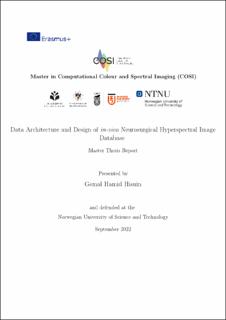| dc.description.abstract | In recent years, the use of hyperspectral imaging (HSI) for microneurosurgical applications has been introduced. One of the most significant challenge that researchers and neurosurgeons face when developing or applying hyperspectral methods for neurosurgical applications is the absence of publicly available hyperspectral data with appropriate metadata, anatomical accuracy, patient characteristics, and reflectance properties of brain tissues and tumor. This work's goals were to create an application for visualizing the reflectance spectral signature of various tissue and tumor characteristics using a gold standard dataset collected by the research group, as well as to assess the focus quality of the band images. Using this data, a reference of brain tissue and tumor spectral signatures was created, which was subsequently utilized to identify more than 9 distinct tissue classes and tumors that may be used to delineate brain tumors during intraoperative neurosurgical operations. For improved accessibility and usability, a data architecture was designed to illustrate the flow of microneurosurgical data acquisition, storage, processing, and display. A database system with a web-frontend was developed to store and display hyperspectral images and complement the dataset with magnetic resonance and computed tomography images. The hyperspectral imaging clinical database can also be utilized to further develop HSI algorithms and machine learning-based neurosurgical applications.
In addition, out-of-focus in the acquired spectral images is one of the main drawbacks in the brain tissue and tumor delineation and identification. And, to evaluate the focus of those images, quality evaluation techniques that are known to provide good results with RGB images were tested on the band images of our hyperspectral images. As a result, this study examines a blur-based no-reference image quality assessment algorithms for evaluating the sharpness of the band images. A hyperspectral image dataset was created for this purpose by blurring the same spectral band image with different blur levels of gaussian filter, one acquired between 500 nm and 950 nm and the other between 500 nm and 900 nm, and each independent wavelength was analyzed. Perceptual Sharpness Index (PSI) focus assessment method performed better in the spectral bands of neurosurgical images. Also, focus differences were noticed in the final wavelength range between 900 nm and 950 nm, even though, the results show focus consistency in the acquired dataset between 500 nm and 900 nm. | |
